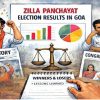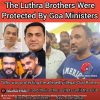Goa is abuzz with excitement as vintage bike and car owners, users, collectors and fans are decking […]

BREAKING BARRIERS TO HEALTHCARE ACCESS: The Goa Model
Dec 14- Dec 20 2024, MIND & BODY, HEART & SOUL December 13, 2024Universal Health Coverage Day
On December 12 the WHO observes Universal Health Coverage (UHC) Day, a reminder of the global commitment to achieving health for everyone, everywhere. This year the theme is “HEALTH: It’s on the Government” — emphasizing the crucial role of governments in ensuring equitable, quality healthcare. “The Goa Model’ of Health Care is a perfect example of Universal Health Coverage and health for all has always been center to our health care delivery system.” Dr Amit Dias spoke to us at length on Universal Health Care Day.
Q&A Interview with Dr Amit Dias
Goan Observer: Doctor could you start by explaining, what is meant by Universal Health Coverage, and how did this concept come about?
Dr Amit Dias: Universal Health Coverage (UHC) means ensuring that all individuals and communities receive the health services they need without suffering financial hardship. It includes a full spectrum of essential, quality health services — from health promotion to prevention, treatment, rehabilitation, and palliative care.
The concept of UHC gained traction in 2005 when WHO member states adopted a resolution urging countries to transition towards universal coverage. The idea builds on the 1978 Alma-Ata Declaration on Health for All, which identified health as a fundamental human right. The 2012 UN resolution further solidified global consensus on UHC as a key driver of sustainable development.
The Goa model for health care is a perfect model for Universal Health Coverage and there is a lot that the other states can learn from our model. The government understands its responsibility and has been constantly upgrading the health care system by introducing innovative strategies in health care to reach out to all.
Q: How does UHC align with the concept of Health for All?
A: UHC operationalizes the vision of Health for All by focusing on equity. It ensures no one is left behind due to their socioeconomic status, gender, or geographic location. Health for All is a moral imperative; UHC provides the framework for translating this vision into actionable policies and programs.
Q: Why is UHC necessary?
A: Health care can be very expensive, catastrophic health care costs have driven families to poverty overnight, some people are more vulnerable than others. UHC is vital for reducing the gaps and disparities in health outcomes. These gaps disproportionately affect vulnerable populations, perpetuating cycles of poverty and poor health.
According to the WHO:
• Over 2 billion people face catastrophic or impoverishing health expenditures annually.
• Nearly half of the global population lacks access to essential health services.
• The healthcare workforce gap will rise to 18 million by 2030, with the greatest need in low- and middle-income countries (LMICs).
Q: Can you comment on the Goa model? How does Goa provide Universal Health Coverage in the state?
A: Healthcare has always been a priority in the state of Goa. Goa’s approach to Universal Health Coverage (UHC) has been progressive, with a focus on equitable healthcare delivery, leveraging its relatively smaller population, and prioritizing innovative health programs. Here are the key elements of the Goa model for UHC that makes it unique.
- Comprehensive Public Health Infrastructure
Goa has a well-established network of Primary Health Centers (PHCs), Community Health Centers (CHCs), and district hospitals. These facilities ensure that both urban and rural populations have access to essential healthcare services. The state has also invested in mobile health units to reach remote areas. The Health department is constantly in the process of improving the quality of services and ensuring the best health care to the people through the health and wellness centers of Ayushman Bharat Arogya Mandir.
2.Ayushman Bharat Integration
Goa has adopted the Ayushman Bharat-Pradhan Mantri Jan Arogya Yojana (PM-JAY), providing health insurance coverage to vulnerable populations. The scheme covers tertiary care and critical treatments that are otherwise expensive. Additionally, the state supplements this with its own healthcare initiatives to fill coverage gaps.
- Deen Dayal Swasthya Seva Yojana (DDSSY)
Goa launched the comprehensive health insurance for all its residents, called the Deen Dayal Swasthya Seva Yojana (DDSSY), before the National Insurance scheme was launched. This scheme ensures that even the middle-income population has access to quality healthcare without financial hardship and opens doors to private health care as well. - Focus on Preventive and Primary Care
Goa emphasizes preventive healthcare, with programs targeting immunization, maternal and child health, and non-communicable diseases (NCDs). Initiatives like screening for hypertension, diabetes, and cancer are regularly conducted at PHCs as well as the health and wellness centers. - Mental Health Integration
The Goa government has integrated mental health services into its primary healthcare system, a pioneering effort in India. District Mental Health Program ensure accessible mental health services across the state. Sangath, an NGO based in Goa has developed several innovative models for bridging the gaps in mental health services that can solve the problem in the world. - Accessibility and Affordability
There is a network of health care services in the state with a free ambulance service for emergency care. The medical costs, essential drugs, cancer care, surgeries are all provided free of cost. We also have a new super speciality block started at the Goa Medical College which provided free health care. This significantly reduces the out-of-pocket expenditure for citizens. - Support for Elderly and Chronic Care
Goa has specific programs for the elderly, including free health check-ups and home visits for bedridden patients. Additionally, the state provides free dialysis services for patients with chronic kidney diseases even at the PHC level. New outreach models are being developed. - Digital Health and Telemedicine
The state is exploring telemedicine platforms to improve access to specialist care in remote areas. Digital health records are being implemented for better coordination of care.
Scope for improvement:
Despite these efforts, the Goa model is not without challenges:
- Workforce Shortages
- Infrastructure Gaps in Remote Areas
- Awareness and Health Literacy
- Long-Term Care
Goa’s model demonstrates that a small state with focused governance can achieve significant strides toward UHC. The integration of public health initiatives with state-sponsored insurance schemes like DDSSY ensures equitable access to quality healthcare. However, sustaining and scaling up these efforts while addressing emerging challenges will require continuous investment, innovation, and community participation.
If other states can learn from and adapt Goa’s approach, particularly its insurance schemes and mental health integration, India can make significant progress toward achieving UHC nationally.
Q: What are the barriers to achieving UHC?
A: In general the barriers include:
- Financial barriers: High out-of-pocket costs deter people from seeking care.
- Geographic barriers: Rural and remote populations often lack healthcare infrastructure.
- Workforce shortages: Insufficient trained healthcare professionals.
- Cultural and informational barriers: Language differences, stigma, and lack of awareness.
- Weak governance: Inefficient health systems and corruption.
One needs to provide the five A’s which are essential for universal health coverage.
Q: Can you elaborate on the 5 A’s that need to be addressed for UHC?
A: Certainly. The 5 A’s are:
- Accessibility: Physical availability of healthcare services.
- Affordability: Ensuring healthcare costs are not a financial burden.
- Acceptability: Cultural and social relevance of healthcare services.
- Adequacy: Sufficient resources, including infrastructure and personnel.
- Awareness: Educating people about their health rights and available services.
Each “A” must be tackled comprehensively to achieve true universal coverage.
Q: Why is it the government’s responsibility to provide UHC?
A: Yes, this has been clearly emphasized in the theme for this year proposed by the WHO. Health is a state subject and it is the responsibility of the state to provide quality health care at a cost that people can afford. Healthcare is a public good, and equitable access to it is foundational for societal development. Governments have a duty to uphold the right to health as enshrined in international human rights treaties.
Moreover, investing in UHC reduces economic inequalities, strengthens workforce productivity, and ensures resilience against health crises like pandemics. It’s the government’s duty to ensure equitable quality healthcare.
I had an opportunity to visit some of the countries abroad due to my work, and I took some time to understand their health care system. Thailand, for example, introduced the Universal Coverage Scheme in 2002, significantly reducing out-of-pocket expenses and achieving nearly 99% population coverage. Similarly, Cuba offers free healthcare with a strong emphasis on primary care and preventive services, resulting in health indicators comparable to high-income countries.
Q: What is your message to readers on Universal Health Coverage Day?
A: My message is simple: Health is a fundamental human right. Let us advocate for systems where no one is left behind. Governments must lead, but civil society, healthcare professionals, and individuals must hold them accountable. Together, we can make health a reality for all.
















